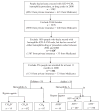Healthcare expenditures for males with haemophilia and employer-sponsored insurance in the United States, 2008
- PMID: 22151000
- PMCID: PMC4530317
- DOI: 10.1111/j.1365-2516.2011.02692.x
Healthcare expenditures for males with haemophilia and employer-sponsored insurance in the United States, 2008
Abstract
Although hemophilia has a potentially high economic impact, published estimates of health care costs for Americans with hemophilia are sparse and non-specific as to the non-bleeding complications of the disease. The objective of this study is to estimate average annual health care expenditures for people with hemophilia covered by employer-sponsored insurance, stratified according to the influence of age, type of hemophilia [A (factor VIII deficiency) versus B (factor IX)], presence of neutralizing alloantibody inhibitors and exposure to blood-borne viral infections. Data from the MarketScan Commercial and Medicare Research Databases were used for the period 2002-2008 to identify cases of hemophilia and to estimate mean and median medical expenditures during 2008. A total of 1,164 males with hemophilia were identified with continuous enrollment during 2008, 933 with hemophilia A and 231 with hemophilia B. Mean health care expenditures were $155,136 [median $73,548]. Mean costs for 30 (3%) males with an inhibitor were 5 times higher than for males without an inhibitor, approximately $697,000 [median $330,835] and $144,000 [median $73,321], respectively. Clotting factor concentrate accounted for 70%-82% of total costs. Average costs for 207 adults with HCV or HIV infection were 1.5 times higher than those for adults without infection. Hemophilia treatment is costly, particularly for individuals with neutralizing alloantibody inhibitors who require bypassing agents. Efforts to understand the cause of inhibitors are needed so that prevention strategies can be implemented and the excess costs resulting from this serious complication of hemophilia care can be avoided.
© 2011 Blackwell Publishing Ltd.
Figures

References
-
- Manco-Johnson MJ, Nuss R, Geraghty S, Funk S, Kilcoyne R. Results of secondary prophylaxis in children with severe hemophilia. Am J Hematol. 1994;47:113–7. - PubMed
-
- Liesner RJ, Khair K, Hann IM. The impact of prophylactic treatment on children with severe haemophilia. Br J Haematol. 1996;92:973–8. - PubMed
-
- Soucie JM, Evatt B, Jackson D the Hemophilia Surveillance System Project Investigators. . Occurrence of hemophilia in the United States. Am J Hematol. 1998;59:288–94. - PubMed
-
- Aledort LM, Haschmeyer RH, Pettersson HA. Longitudinal study of orthopaedic outcomes for severe factor-VIII-deficient haemophiliacs. The Orthopaedic Outcome Study Group. J Intern Med. 1994;236:391–9. - PubMed
-
- Naraine VS, Risebrough NA, OHP, et al. Health-related quality-of-life treatments for severe haemophilia: utility measurements using the Standard Gamble technique. Haemophilia. 2002;8:112–20. - PubMed
MeSH terms
Substances
Grants and funding
LinkOut - more resources
Full Text Sources
Medical

